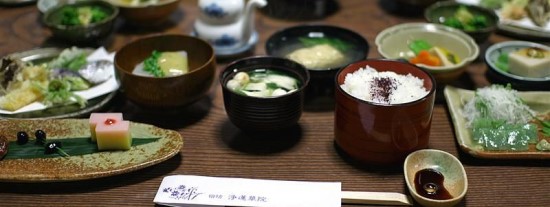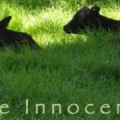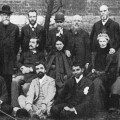 Mitsuru Kakimoto of the Japanese Vegetarian Society writes: “A survey that I conducted of 80 Westerners, including Americans, Englishmen and Canadians, revealed that approximately half of them believed that vegetarianism originated in India. Some respondents assumed that vegetarianism had its origin in China or Japan. It seems to me that the reason Westerners associate vegetarianism with China or Japan is Buddhism. It is no wonder, and in fact we could say that Japan used to be a country where vegetarianism prevailed.”
Mitsuru Kakimoto of the Japanese Vegetarian Society writes: “A survey that I conducted of 80 Westerners, including Americans, Englishmen and Canadians, revealed that approximately half of them believed that vegetarianism originated in India. Some respondents assumed that vegetarianism had its origin in China or Japan. It seems to me that the reason Westerners associate vegetarianism with China or Japan is Buddhism. It is no wonder, and in fact we could say that Japan used to be a country where vegetarianism prevailed.”
Gishi-wajin- denn, a history book on Japan written in China around the third century BC, says, “There are no cattle, no horses, no tigers, no leopards, no goats and no magpies in that land. The climate is mild and people over there eat fresh vegetables both in summer and in winter.” It also says that “people catch fish and shellfish in the water.” Apparently, the Japanese ate fresh vegetables as well as rice and other cereals as staple foods. They also took some fish and shellfish, but hardly any meat.
Shinto, the prevailing religion at the time, is essentially pantheistic, based upon the worship of the forces of nature. According to writer Steven Rosen, in the early days of Shinto, no animal food was offered in sacrifice because of the injunction against shedding blood in the sacred area of the shrine.
Several hundred years later, Buddhism came to Japan and the prohibition of hunting and fishing permeated the Japanese people. In 7th century Japan, the Empress Jito encouraged “hojo,” or the releasing of captive animals, and established wildlife preserves, where animals could not be hunted.
There are many similarities between the Hindu literature and the Buddhist religions of the Far East. For example, the word Cha’an of the Cha’an school of Chinese Buddhism is Chinese for the Sanskrit word “dhyana”, which means meditation, as does the word “Zen” in Japanese. In 676 AD, then Japanese emperor Tenmu proclaimed an ordinance prohibiting the eating of fish and shellfish as well as animal flesh and fowl.
During the twelve hundred years from the Nara period to the Meiji restoration in the second half of the 19th century, Japanese people enjoyed vegetarian style meals. They usually ate rice as staple food and beans and vegetables. It was only on special occasions or celebrations that fish was served. Under these circumstances the Japanese people developed a vegetarian cuisine, Shojin Ryori (ryori means cooking or cuisine), which was native to Japan.
The word “shojin” is a Japanese translation of “vyria” in Sanskrit, meaning “to have the goodness and keep away evils.” Buddhist priests of the Tendai-shu and Shingon-shu sects, whose founders studied in China in the ninth century before they founded their respective sects, have handed down vegetarian cooking practices from Chinese temples strictly in accordance with the teachings of the Buddha.
In the 13th century, Dogen, the founder of the Soto sect of Zen, formally established Shojin Ryori or Japanese vegetarian cuisine. Dogen studied and learned the Zen teachings abroad in China, during the Sung Dynasty. He fixed rules aiming to establish the pure vegetarian life as a means of training the mind.
One of the other influences Zen exerted on the Japanese people manifested itself in Sado, the Japanese tea ceremony. It is believed that Esai, founder of the Rinazi-shu sect, introduced tea to Japan and it is the custom for Zen followers to drink tea. The customs preserved in the teaching of Zen lead to a systematic rule called Sado…a Cha-shitsu or tea ceremony room is so constructed as to resemble the Shojin, where the chief priest is at a Buddhist temple.
Food served at a tea ceremony is called Kaiseki in Japanese, which literally means a stone in the breast. Monks practicing asceticism used to press heated stones to their bosom to suppress hunger. Then the word Kaiseki itself came to mean a light meal served at Shojin, and Kaiseki meals had great influence on the Japanese.
The “Temple of the Butchered Cow” can be found in Shimoda, Japan. It was erected shortly after Japan opened its doors to the West in the 1850s. It was erected in honor of the first cow slaughtered in Japan, marking the first violation of the Buddhist tenet against the eating of meat.
An example of a Buddhist vegetarian in the modern age: Kenji Miyazawa, a Japanese writer and poet of the early 20th century, who wrote a novel entitled Vegetarian-Taisai, in which he depicted a fictitious vegetarian congress…His works played an important role in the advocacy of modern vegetarianism. Today, no animal flesh is ever eaten in a Zen Buddhist monastery, and such Buddhist denominations as the Cao Dai sect (which originated in South Vietnam), now boasts some two million followers, all of whom are vegetarian.
The Buddhist teachings are not the only source contributing to the growth of vegetarianism in Japan. in the late 19th century, Dr. Gensai Ishizuka published an academic book in which he advocated vegetarian cooking with an emphasis on brown rice and vegetables. His method is called Seisyoku (Macrobiotics) and is based upon ancient Chinese philosophy such as the principles of Yin and Yang and Taoism. Now some people support his method of preventative medicine. Japanese macrobiotics suggest taking brown rice as half of the whole intake, with vegetables, beans, seaweeds, and a small amount of fish (optional, but not required).
In his 1923 book, The Natural Diet of Man, Adventist physician Dr. John Harvey Kellogg writes: “According to Mori, the Japanese peasant of the interior is almost an exclusive vegetarian. He eats fish once or twice a month and meat once or twice a year.” Dr. Kellogg writes that in 1899, the Emperor of Japan appointed a commission to determine whether it was necessary to add meat to the nation’s diet to improve the people’s strength and stature. The commission concluded that as far as meat was concerned, “the Japanese had always managed to do without it, and that their powers of endurance and their athletic prowess exceeded that of any of the Caucasian races. Japan’s diet stands on a foundation of rice.”
According to Dr. Kellogg: “the rice diet of the Japanese is supplemented by the free use of peanuts, soy beans and greens, which… constitute a wholly sufficient bill of fare. Throughout the Island Empire, rice is largely used, together with buckwheat, barley, wheat and millet. Turnips and radishes, yams and sweet potatoes are frequently used, also cucumbers, pumpkins and squashes. The soy bean is held in high esteem and used largely in the form of miso, a puree prepared from the bean and fermented; also tofu, a sort of cheese; and cho-yu, which is prepared by mixing the pulverized beans with wheat flour, salt, and water and fermenting from one and a half to five years.
“The Chinese peasant lives on essentially the same diet, as do also the Siamese, the Koreans, and most other Oriental peoples. Three-fourths of the world’s population eats so little meat that it cannot be regarded as anything more than an incidental factor in their bill of fare. The countless millions of China,” writes Dr. Kellogg, “are for the most part flesh-abstainers. In fact at least two-thirds of the inhabitants of the world make so little use of flesh that it can hardly be considered an essential part of their dietary…”
Misturu Kakimoto concludes: “Japanese people started eating meat some 150 years ago and now suffer the crippling diseases caused by the excess intake of fat in flesh and the possible hazards from the use of agricultural chemicals and additives. This is persuading them to seek natural and safe food and to adopt once again the traditional Japanese cuisine.”
………………………………………………………………………………………………………….
This article is written by Vasu Murti
Vasu is the author of the 2003 book, They Shall Not Hurt Or Destroy, which discusses animal rights and vegetarianism in the Western religious traditions: Judaism, Christianity, Islam, the Baha’i faith, Pythagoreanism and neo-Platonism.
They Shall Not Hurt Or Destroy, is available for only $15 (this includes US shipping & handling) from:
Vegetarian Advocates Press
PO Box 201791
Cleveland, OH 44120






3 Comments
Chia (324 comments)
October 18, 2010 at 8:23 pmThank you for sharing this article. – It’s always been said that the Japanese people of the past lived the longest because of their diets which contributed to their good health. And I totally believe this and am reminded of this each time I eat simple macrobiotic cuisine (at restaurants and at home). At home, a meal could be as simple as: sprouted (i.e. soaked overnight) then cooked brown rice + steamed greens of choice + optional cooked beans + perhaps a little bit of baked pumpkin or butternut squash. Served with a side of sauerkraut or kimchi to aid digestion. Drizzle with a little bit of healthy cold pressed oil (flax, sunflower, sesame). Delicious and hearty.
mkpurvis (1 comments)
October 20, 2010 at 8:32 pmNote that Misturu Kakimoto’s article defines “meat” as essentially red meat, so fish are considered to be part of “traditional Japanese cuisine”. When I have been in Japan, I have found it difficult (but not impossible) to find a restaurant serving truly vegetarian fare.
AndyT (6 comments)
October 26, 2010 at 6:48 amThank you for posting this and introducing me to shojin ryori kitchen! Although I love Japanese food, I had been under the assumption that Japanese cuisine was all about fish-derived dashi, hence I only had a few traits I could sample in normal Japanese (most of the time: Sushi) restaurants. I have just ordered 2 cookbooks (http://www.amazon.com/Enlightened-Kitchen-Vegetable-Dishes-Temples/dp/4770024932/ref=sr_1_1?ie=UTF8&s=books&qid=1288100825&sr=8-1 and http://www.amazon.com/Japanese-Cooking-Contemporary-Traditional-Delicious/dp/1570670722/ref=pd_sim_b_2 ) and can’t wait for them to arrive!
Best regards,
Andy